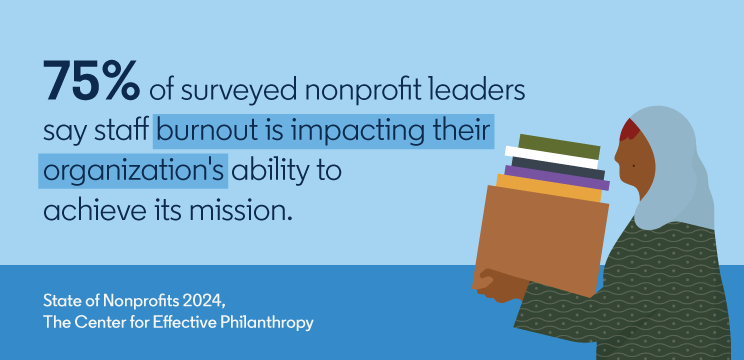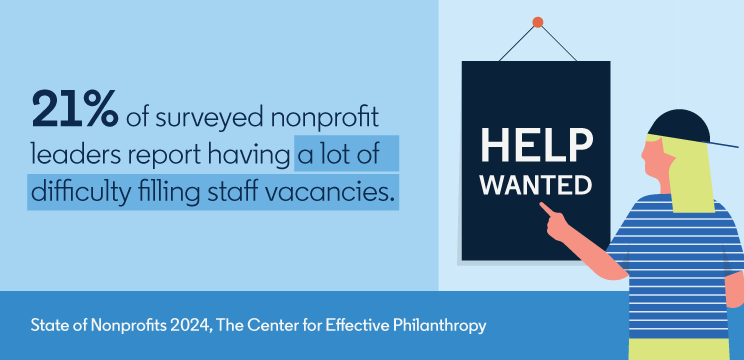
3 Big Challenges of Nonprofit Staffing and How to Solve Them
Nonprofit staffing is proving difficult for many organizations right now. Not only are many employees leaving, but organizations are having a more difficult time replacing them than usual.
For the State of Nonprofits 2024 report, the Center for Effective Philanthropy (CEP) surveyed leaders from 239 U.S. nonprofits to get a sense of the biggest challenges facing their organizations today. Less than half of the respondents said that a typical or lower than typical number of staff members left their organization in the last year, suggesting turnover is rising. At the same time, more than two-thirds (69%) of leaders reported having at least a little difficulty filling staff vacancies, with 21% reporting significant difficulties.
If you’re concerned about staffing at your nonprofit, know that you’re not alone. Here are three of the biggest challenges reported by nonprofit leaders — and some ideas that may help you overcome them.
Challenge #1: Nonprofit staff are burnt out
Nearly all (95%) of the nonprofit leaders surveyed by CEP expressed some level of concern about staff burnout, a number largely unchanged since the 2023 edition of the report. And with 75% of respondents reporting that staff burnout is slightly to significantly impacting their organization's ability to achieve its mission, this is a challenge that all stakeholders should be concerned about.
Burnout can be a vicious cycle. When staff members feel overworked and burnt out, they’re more likely to leave their jobs. The more staff members leave their jobs, the more strain is placed on the team members who remain, increasing their risk of burnout, too.

Solutions:
Build open and constructive lines of communication: Encourage managers to check in regularly with direct reports to gauge their workload and stress levels and make adjustments if needed. Ensure managers are fostering an environment where all team members feel comfortable speaking up if they’re struggling.
- Provide resources for managing burnout: Whether in one-on-one conversations or via team-wide emails (or both), share resources to help prevent burnout and increase staff well-being. If your organization uses LinkedIn Learning, this could include recommending courses like “Combating Burnout with Mindfulness.”
Use AI to reduce busywork: More than half of nonprofit leaders surveyed by CEP said they were exploring how AI might supplement and support their staff’s work. Using AI to streamline routine work could help you free up more of your staff’s time and energy, empowering them to focus on the tasks they enjoy the most. Try these tips for getting started with AI at your nonprofit.
- Help employees feel fulfilled in their careers: It’s just not the amount of work that can trigger burnout. If staff feel like their careers are growing stagnant, they’re more likely to grow disengaged, making them susceptible to burnout. You can address this by demonstrating your commitment to helping them grow their career at your nonprofit, such as by working with them to outline a professional development plan and providing learning resources to help them take the next step.
Challenge #2: It’s getting harder to fill frontline roles
While most of the nonprofit leaders surveyed by CEP reported at least some level of difficulty filling staff vacancies, this challenge was acutely felt by the leaders of organizations whose work includes a direct service component.
This is backed up by other research, including a 2023 report from the National Council of Nonprofits, which found that the most commonly unfilled nonprofit jobs tended to be those that interact with the public the most.
Solutions:
- Develop a compelling, inclusive employer brand: Does your nonprofit’s employer brand speak to frontline workers as well desk-based employees? Think about ways to communicate the unique impact that these roles have on your organization and the communities you serve, and consider elevating the voices of frontline employees in the employer branding content that your organization shares.
Revisit your job descriptions: If your frontline roles aren’t attracting many applicants, are there ways that you could make your job descriptions more engaging, such as emphasizing growth opportunities that you offer? It may also be worth sitting down with the hiring manager to discuss whether every requirement is strictly necessary from day one, as this may be limiting your candidate pool. Are there skills that a new hire is likely to pick up on the job? If so, it may be time to cut them from your list of requirements.
- Meet candidates where they are: Sometimes, where you look for talent is just as important as what you look for. LinkedIn Talent Insights can help you identify where the talent you’re looking for is concentrated, so you can direct your search more strategically. As of April 2024, there were 175 million firstline and hourly workers on LinkedIn.

Challenge #3: Staff want more flexibility and may leave to find it
Across industries, employees’ appetite for remote and flexible work options remains strong — and they may be willing to leave their current jobs to find them.
CEP found that, among leaders reporting a higher than typical staff turnover rate, one of the most commonly cited reasons for departures was an inability to provide competitive benefits like remote work or flexible hours. While these perks can be especially difficult to offer for certain types of jobs, including many frontline roles, organizations may need to get creative to attract and retain the talent they need.
Solutions:
Work with HR to understand what flexibility you can offer: Even if your nonprofit can’t provide remote or hybrid work options for every role, are there other kinds of flexibility — formal or informal — that you can offer? For example, could employees leave early to pick their kids up from school and finish the final hour of the day from home? And if you simply can’t offer remote or flexible options to some staff, are there other perks you could offer them instead, like one day off a month to help recharge their batteries? Whatever level of flexibility you land on, be sure to communicate it clearly to employees — explaining the reasons why these decisions were made, listening to their feedback, and emphasizing your organization’s commitment to supporting their work-life balance and well-being.
Equip managers with the skills they need to support flexible work: Workplace flexibility is only sustainable if managers know how to navigate it. If you use LinkedIn Learning, ask managers to complete a course like “How to Support Flexible Work as a Manager” to help them lead their teams effectively in a flexible environment. Maintaining strong lines of communication and fostering trust are key.
Nonprofit staffing is a major concern for many nonprofit teams. To discuss your organization’s biggest hiring challenges and identify the right solutions for you, reach out to our team today.

